The Supermicro SuperServer 2028U-TNR4T+ is a high-end server that leverages the CSE-219UAC-R1K02 2U server chassis where the SC219UAC(4)-R1K02 2U server chassis and the X10DRU-i+ dual processor serverboard subsystems reside. Like other SuperServers before it, the 2028U-TNR4T+ offers a ton of flexibility for use cases that involve intense application workloads using its equipped 8x SATA3 (6Gbps), 24x SAS3 ports support via optional add-on Cards, and 4x NVMe slots, the latter which is two more than the 1028U SuperServer. We recently leveraged the 2028U-TNR4T+ to test the Intel SSD DC P3700, Memblaze PBlaze4, and Samsung XS1715 2.5″ NVMe SSDs as well as the Huwei ES3000, HGST SN100, Memblaze PBlaze, and Intel P3608 HHHL AIC form factor NVMe SSDs.
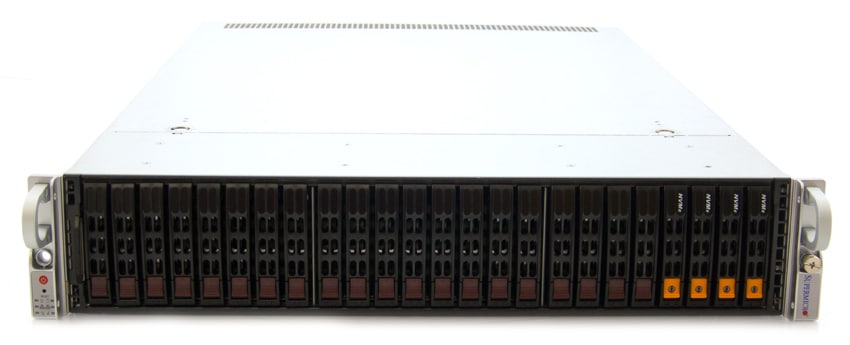
NVMe support is a huge selling point for the 2028U-TNR4T+ as more and more businesses are adopting the growing technology due to its ability to boast high-speed, low-latency connections directly from the CPU to NVMe SSDs. In addition, it adds a ton of power to drive throughput while significantly reducing storage device latency, as it directly interfaces with PCI-E between the CPU and the NVMe SSDs. The 2028U-TNR4T+ is equipped 24 memory sockets that can support upwards of 768GB of DDR4 non-volatile RDIMM or 1536GB of LRDIMM DDR4 memory. Like most Supermicro servers, the 2028U-TNR4T+ leverages a SATA controller that has been integrated into the chipset, creating a ten-port SATA subsystem; six of which are supported by the Intel PCH while the other four are supported by the Intel SCU.
We configured our SuperServer 2028U-TNR4T+ with 768GB of Crucial DDR4 RAM (32GB x 24) and two Intel E5-2697v3 CPUs with the Supermicro AOC-S3008L-L8i HBA to enable the 24 SAS3 bays, skipping the SATA configuration option. We will also be leveraging 4x 10GBase-T ports via AOC-2URN4-i4XT. To show the performance of the SuperServer, we will be referencing the recently reviews NVMe SSDs mentioned above.
Supermicro SuperServer 2028U-TNR4T+ Specifications
- Motherboard: Super X10DRU-i+
- CPU:
- Intel Xeon processor E5-2600 v3 family (up to 160W TDP)
- Dual Socket R3 (LGA 2011)
- Cores / Cache: Up to 18 Cores / Up to 45MB Cache
- System Bus: QPI up to 9.6 GT/s
- System Memory
- Memory Capacity:
- 24x 288-pin DDR4 DIMM slots
- Up to 1.5TB ECC LRDIMM, RDIMM
- Memory Type: 2133/1866/1600MHz ECC DDR4 SDRAM 72-bit
- DIMM Sizes: 64GB, 32GB, 16GB, 8GB, 4GB
- Memory Voltage: 1.2 V
- Error Detection: Corrects single-bit errors
- Memory Capacity:
- On-Board Devices
- Chipset: Intel C612 chipset
- SATA: SATA3 (6Gbps) with RAID 0, 1, 5, 10
- IPMI:
- Support for Intelligent Platform Management Interface v.2.0
- IPMI 2.0 with virtual media over LAN and KVM-over-LAN support
- ASPEED AST2400 BMC
- Network Connectivity
- 4x 10GBase-T ports via AOC-2URN4-i4XT
- Intel X540 10GBase-T
- 1x Realtek RTL8211E PHY (dedicated IPMI)
- Graphics: ASPEED AST2400 BMC
- Input / Output
- SATA: 8x SATA3 (6Gbps) ports
- SAS: 24x SAS3 ports support via optional Add-on Cards
- NVMe: 4x NVMe ports
- LAN:
- 4x RJ45 10GBase-T LAN ports
- 1x RJ45 Dedicated IPMI LAN port
- USB: 5x USB 3.0 ports (2 rear, 2 onboard header, 1 Type A)
- Video: 1x VGA Connector
- Serial Port / Header: 1x Serial header
- DOM: 2x SuperDOM (Disk on Module) ports
- System BIOS:
- BIOS Type: 128Mb SPI Flash EEPROM with AMI BIOS
- BIOS Features:
- Plug and Play (PnP)
- APM 1.2
- PCI 2.3
- ACPI 1.0 / 2.0 / 3.0 / 4.0
- USB Keyboard support
- SMBIOS 2.7.1
- UEFI 2.3.1
- Management:
- Software:
- SuperDoctor 5
- Intel Node Manager 3.0
- Watch Dog
- NMI
- SMCBU and SMM
- Optional IPMI 1.5 / 2.0
- Software:
- Power Configurations:
- ACPI Power Management
- Power-on mode for AC power recovery
- Chassis:
- Form Factor: 2U Rackmount
- Model: CSE-219UAC-R1K02
- Dimensions and Weight:
- Width: 17.2″ (437mm)
- Height: 3.5″ (89mm)
- Depth: 27.76″ (705.3mm)
- Weight:
- Net Weight: 36 lbs (16.4 kg)
- Gross Weight: 72 lbs (32.7 kg)
- Front Panel
- Buttons:
- Power On/Off button
- System Reset button
- LEDs:
- Power status LED
- HDD activity LED
- 2x Network activity LEDs
- System information (overheat/UID) LED
- Buttons:
- Expansion Slots
- PCI-Express: 6x PCI-E 3.0 x8 slots (4x FH, 10.5″ L, 1x LP, 1x Internal LP)
- Drive Bays (Hot-swap):
- 24x 2.5″ Hot-swap drive bays
- Default 8x SATA3 ports and 4x NVMe ports
- Optional 24x SAS3 ports via AOC
- Fans: 4x 8cm heavy duty PWM fans
- Power Supply with Digital Switching Control:
- 0W Redundant Titanium Level (96%) Single Output Power Supplies
- AC Input:
- 100-127 V, 50-60 Hz
- 200-240 V, 50-60 Hz
- +12V:
- Max: 62.5A & Min: 0A (100Vac-127Vac)
- Max: 83A (200Vac-240Vac) & Min: 0A
- 12V SB:
- Max: 2.1A
- Min: 0A
Design and build
Supermicro SuperServer 2028U-TNR4T+ is a 2U form factor build with 24 hot-swappable 2.5″ SAS/SATA drive bays; 8x SATA3 ports and 4x NVMe ports with an optional 24x SAS3 ports via AOC. This is certainly a ruggedly built server that can take any bumps along the way.
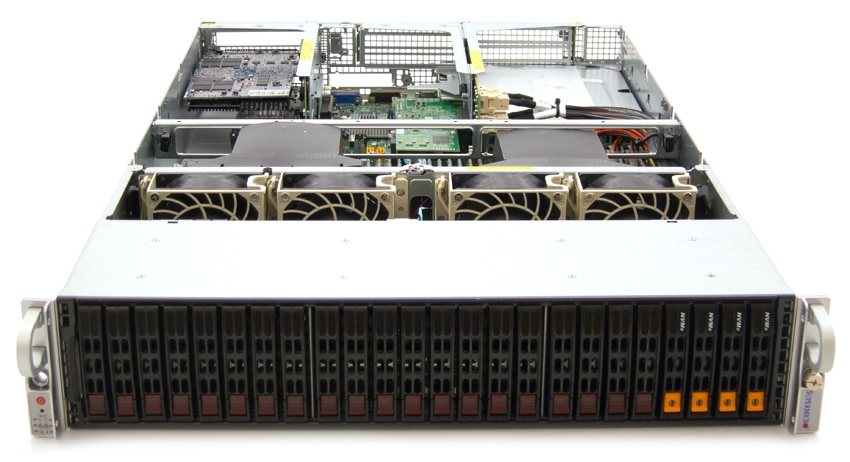
The control panel is found on the front side of the server, on the outside edge of the chassis, where the power and reset buttons reside. The control panel LEDs are also located on the left side of the chassis, including the Information LED, which alerts the operator of several states, the NIC1 and NIC2 LEDs, which indicates network activity on GLAN2 when flashing; the Power LED, which indicates when power is being supplied to the system power supply units; and the HDD LED, which indicates IDE channel activity on the hard drive when it is flashing. In addition, each drive carrier has two status LEDs on the front of the carrier.
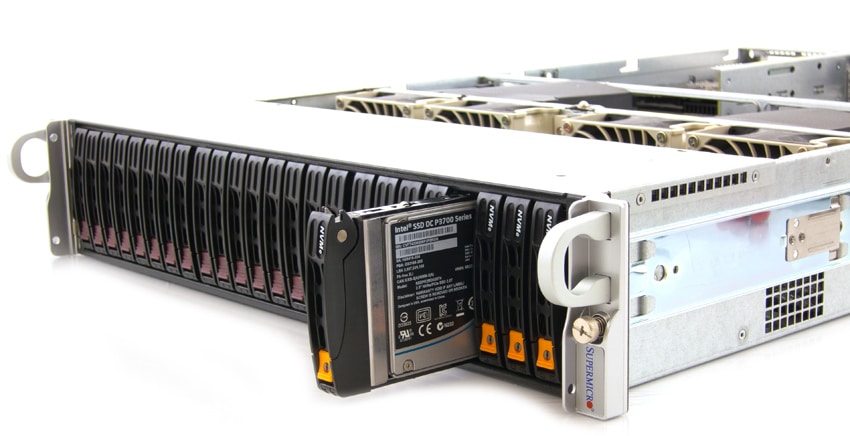
Various expansion card slots are located on the back panel, including Double Width, full height, full length and full Height, full length. I/O Ports include 2x USB 3.0 ports, IPMI_dedicated LAN port, COM port, and a VGA port. Supermicro indicates that there are several possible networking configurations depending on the pre-installed Ultra riser card. In addition, the back panel shows two separate power modules for power redundancy. This allows for continued operation without having to shut down the server while IT replaces a failed power supply module.
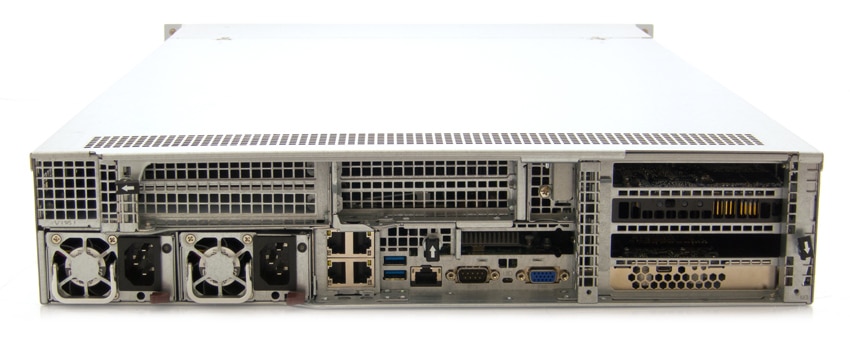
To remove the chassis cover, simply loosen one screw on the back of the chassis cover, which will allow it to easily slide off. Supermicro is known from their organized layout of their components and the 2028U-TNR4T+ is no exception with the SUPER X10DRU-i+ motherboard. On the far right includes an assortment of SATA ports partially obstructed by the NVMe cabling routing on that side of the chassis.
The serverboard shows the dual Intel E5-2600v3 Series processor in LGA2011 sockets (Socket R3) as well as 24 memory sockets that support up to 768GB of ECC registered DDR4-1600/1333/1066/800 non-volatile RDIMM or 1536GB of LRDIMM DDR4-2133/1866/1600/1333 memory.
Application Workload Analysis
Our first benchmarks consist of the MySQL OLTP performance via SysBench and Microsoft SQL Server OLTP performance with a simulated TPC-C workload. For our application workloads each drive will be running 4 identically configured VMs.
StorageReview’s Microsoft SQL Server OLTP testing protocol employs the current draft of the Transaction Processing Performance Council’s Benchmark C (TPC-C), an online transaction processing benchmark that simulates the activities found in complex application environments. The TPC-C benchmark comes closer than synthetic performance benchmarks to gauging the performance strengths and bottlenecks of storage infrastructure in database environments. Our SQL Server protocol for this review measures the transactional performance and latency under a load of 15,000 virtual users.
Second Generation SQL Server OLTP Benchmark Factory LoadGen Equipment
- Dell PowerEdge R730 VMware ESXi vSphere Virtual Client Hosts (2)
- Four Intel E5-2690 v3 CPUs for 124GHz in cluster (Two per node, 2.6GHz, 12-cores, 30MB Cache)
- 512GB RAM (256GB per node, 16GB x 16 DDR4, 128GB per CPU)
- SD Card Boot (Lexar 16GB)
- 2 x Mellanox ConnectX-3 InfiniBand Adapter (vSwitch for vMotion and VM network)
- 2 x Emulex 16GB dual-port FC HBA
- 2 x Emulex 10GbE dual-port NIC
- VMware ESXi vSphere 6.0 / Enterprise Plus 4-CPU
- Supermicro SuperServer 2028U-TNR4T+ Virtualized SQL Host
- Two Intel E5-2699 v3 CPUs for 83GHz (2.3GHz, 18-cores, 45MB Cache)
- 768GB RAM (32GB x 24 Crucial DDR4, 384GB per CPU)
- VMware ESXi vSphere 6.0 / Enterprise Plus 2-CPU
When looking at SQL Server Output, the 2028U-TNR4T+ boasted its top performance with the Intel DC SSD P3700 drives, recording an aggregate of 3,157.341 TPS while individual VMs ranged from 3,157.469 TPS through 3,157.143 TPS. The Memblaze drive had great performance as well, measuring a top TPS of 3,157.235 and an aggregate of 3,157.112 TPS.
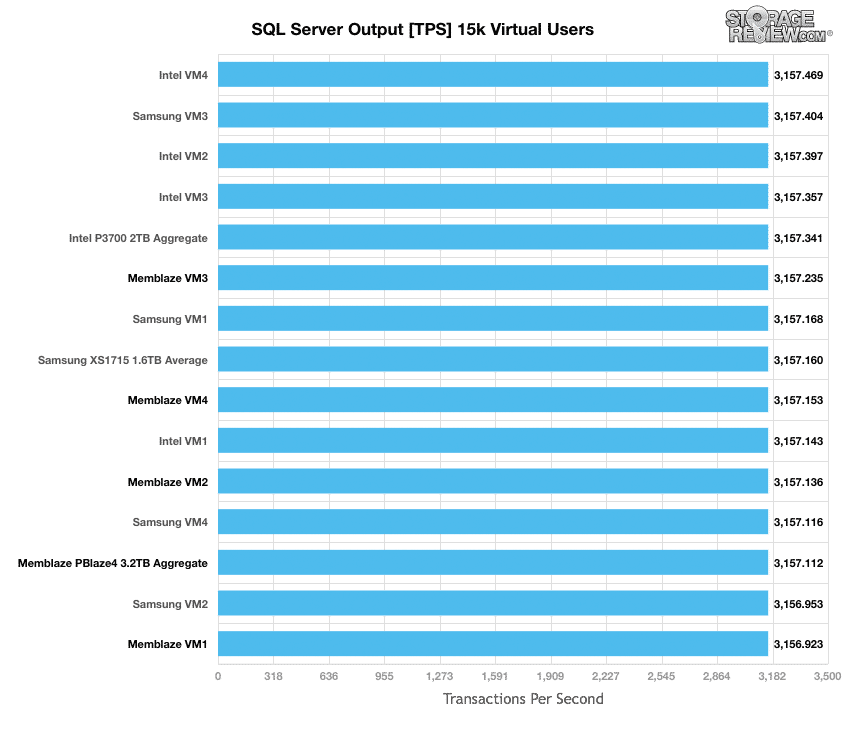
Looking at average latency results during the 15k user SQL Server benchmark showed the 2028U-TNR4T+ record impressive results with the Samsung and Intel SSDs, both of which posted 7.0ms.
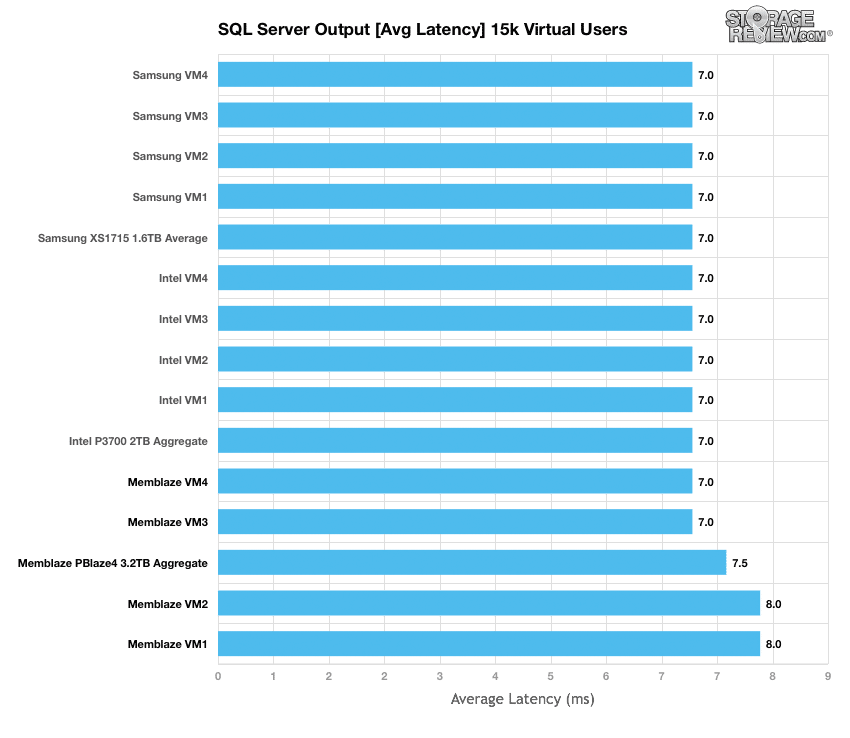
Supermicro SuperServer 2028U-TNR4T+ Virtualized Sysbench Host
- Two Intel E5-2699 v3 CPUs for 83GHz (2.3GHz, 18-cores, 45MB Cache)
- 768GB RAM (32GB x 24 Crucial DDR4, 384GB per CPU)
- VMware ESXi vSphere 6.0 / Enterprise Plus 2-CPU
The Sysbench OLTP benchmark runs on top of Percona MySQL leveraging the InnoDB storage engine operating inside a CentOS installation. To align our tests of traditional SAN with newer hyper-converged gear, we’ve shifted many of our benchmarks to a larger distributed model. The primary difference is that instead of running one single benchmark on a bare-metal server, we now run multiple instances of that benchmark in a virtualized environment. Leveraging several NVMe SSDs, we deployed 4 Sysbench VMs on the 2028U-TNR4T+ and measured the total performance seen on the host with all operating simultaneously.
In the average transactions per second benchmark, the 2028U-TNR4T+ performed its best with the Intel SSD DC P3700 with an impressive 5,779.7 TPS in aggregate performance. The Memblaze configuration wasn’t far behind, however, as it boasted a top TPS performance of 5,717.2.
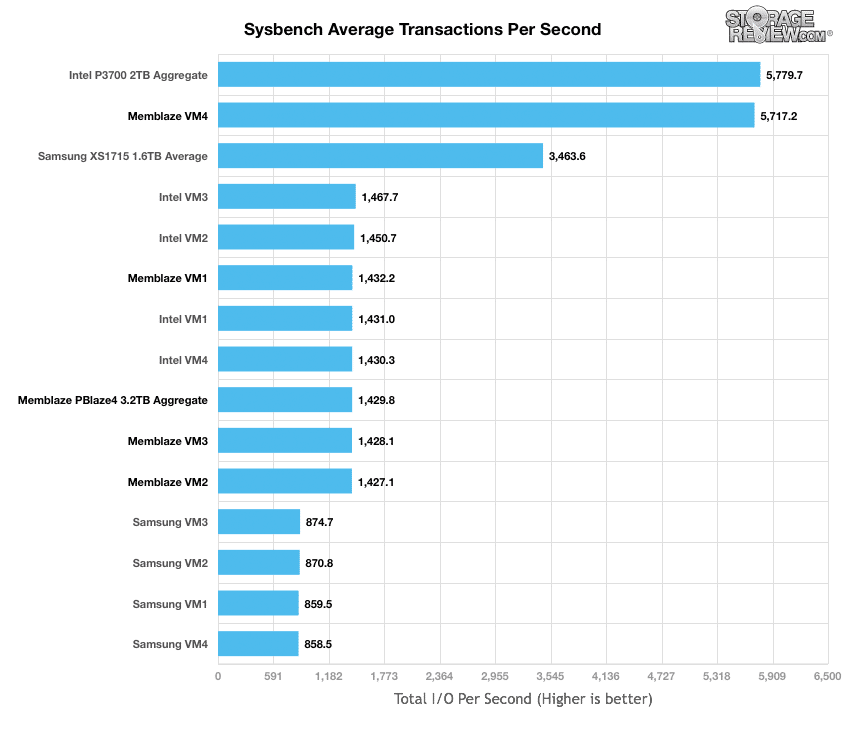
When looking at the average latency of the 2028U-TNR4T+, the Intel again demonstrated top results with 22.15ms aggregate while individual VMs ran between 21.80ms and 22.37ms.
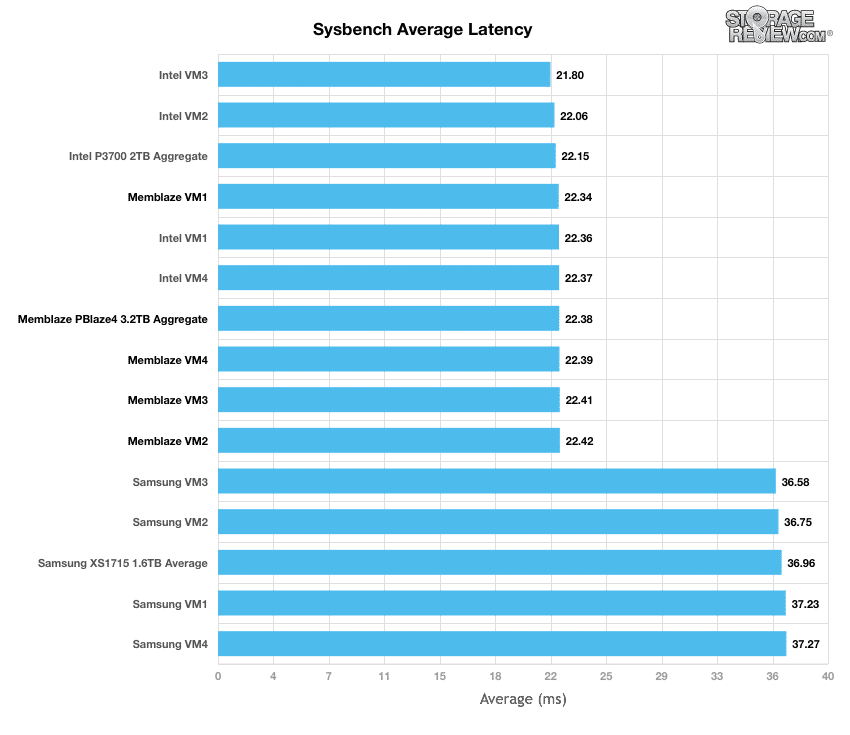
In terms of our worst-case MySQL latency scenario (99th percentile latency), top performance was achieved when populated with the Intel drive, which boasted an impressive aggregate of just 45.97ms.
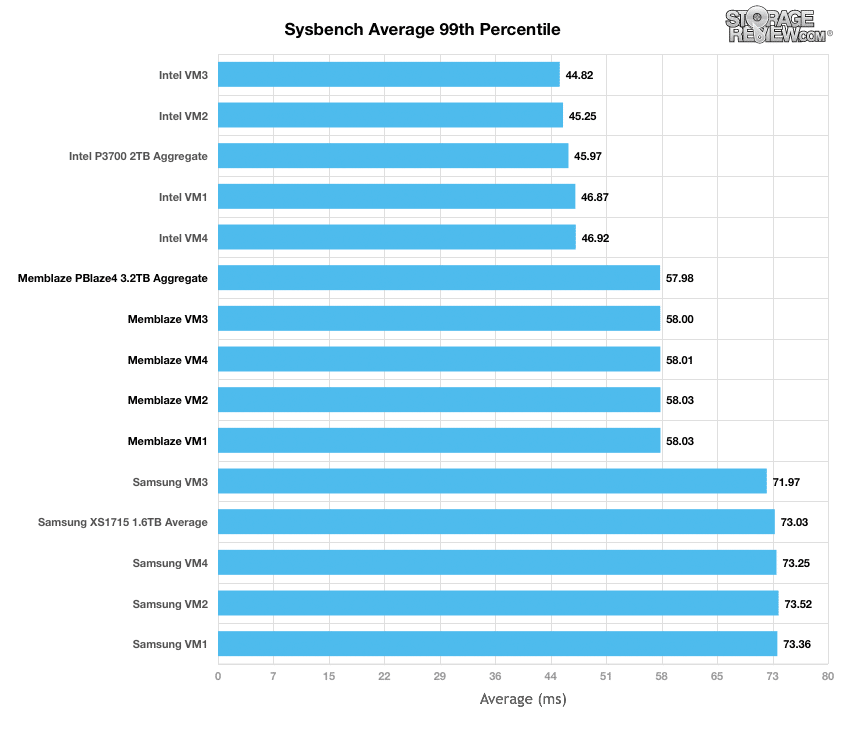
Enterprise Synthetic Workload Analysis
In testing this server, we will be using Intel SSD DC P3700, Memblaze PBlaze4, and Samsung XS1715 2.5″ NVMe SSDs as well as the Huwei ES3000, HGST SN100, Memblaze PBlaze, and Intel P3608 HHHL AIC form factor NVMe SSDs. The Intel P3600 NVMe SSDs are being tested in single and dual drive configurations. In dual drive scores the results of both drives are aggregated to provide the total performance.
Prior to initiating each of the fio synthetic benchmarks, our lab preconditions the device into steady-state under a heavy load of 16 threads with an outstanding queue of 16 per thread. Then the storage is tested in set intervals with multiple thread/queue depth profiles to show performance under light and heavy usage.
Preconditioning and Primary Steady-State Tests:
- Throughput (Read+Write IOPS Aggregated)
- Average Latency (Read+Write Latency Averaged Together)
- Max Latency (Peak Read or Write Latency)
- Latency Standard Deviation (Read+Write Standard Deviation Averaged Together)
This synthetic analysis incorporates four profiles which are widely used in manufacturer specifications and benchmarks:
- 4k – 100% Read and 100% Write
- 8k – 100% Read and 100% Write
- 8k – 70% Read/30% Write
- 128k – 100% Read and 100% Write
During the primary 4k synthetic benchmark, the 2028U-TNR4T+ showed a top read IOPS of 717,172 when populated with the Memblaze drive. The server also topped out at 172,672 IOPS writes, which occurred with the Intel P3700 drives. Looking at peak performance for our HHHL drives showed much higher performance, as the Intel P3608 boasted 851,693 IOPS.
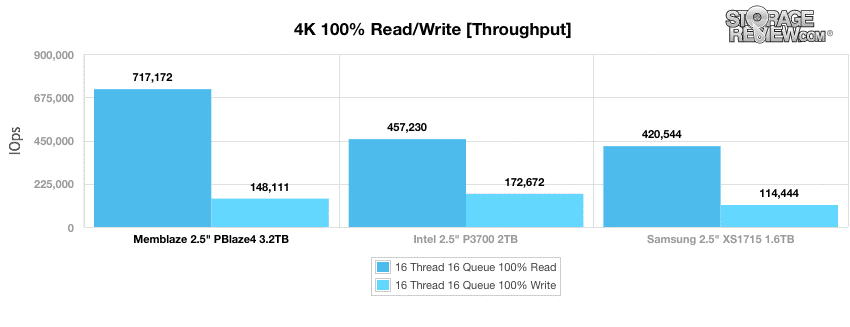
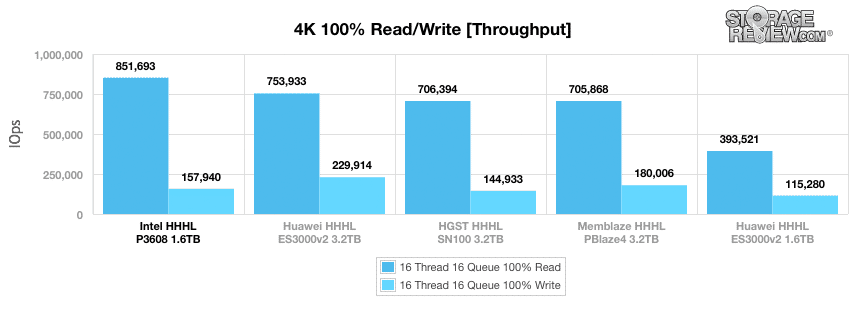
When looking at average latency of the 2028U-TNR4T+ with the tested of our 2.5″ drive, it showed just 0.36ms read via the Memblaze NVMe drive while recording a top 1.48ms in average write latency with the Intel P3700. Looking at the HHHL drive, top read speeds were recorded when populated with the Intel P3608 drive once again, which posted just 0.30ms read.
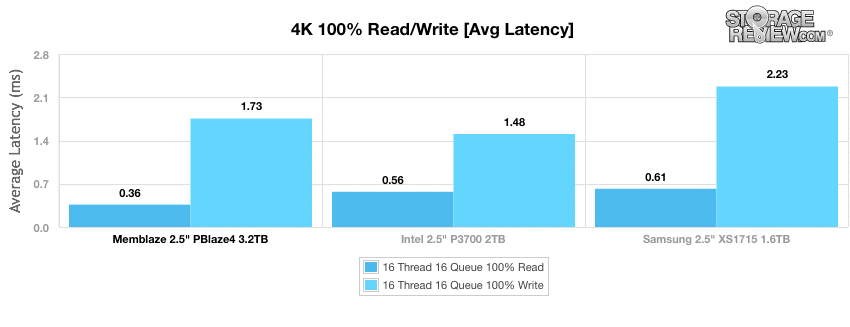
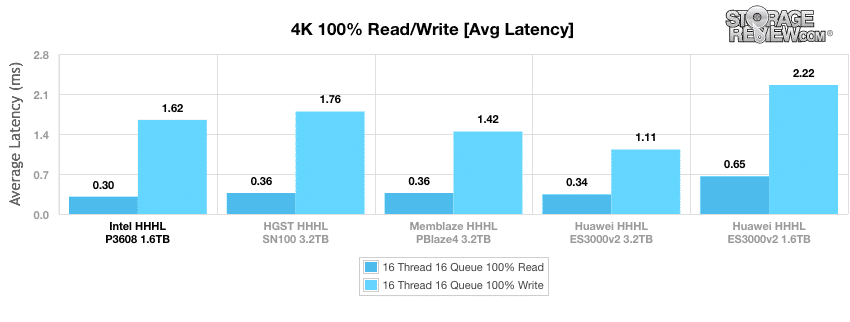
In our next workload, we reconditioned the server for sequential 8k transfers to measure the performance of the NVMe drives with a load of 16 threads and a queue depth of 16 for 100% read and 100% write operations. In this benchmark, the Supermicro server showed the best performance with the Intel drive throughout the entire test up until the very end, where the Memblaze pulled away at the last queue depth reaching over a massive 166,250 IOPS. Of the HHHL drive, the Huawei ES3000 3.2TB drive showed the best performance, reaching just under 300,000 IOPS in the terminal.
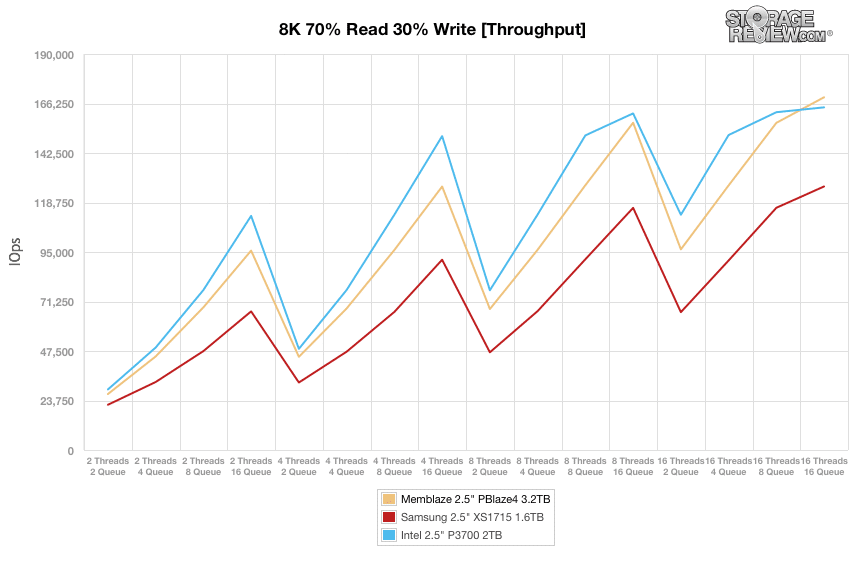
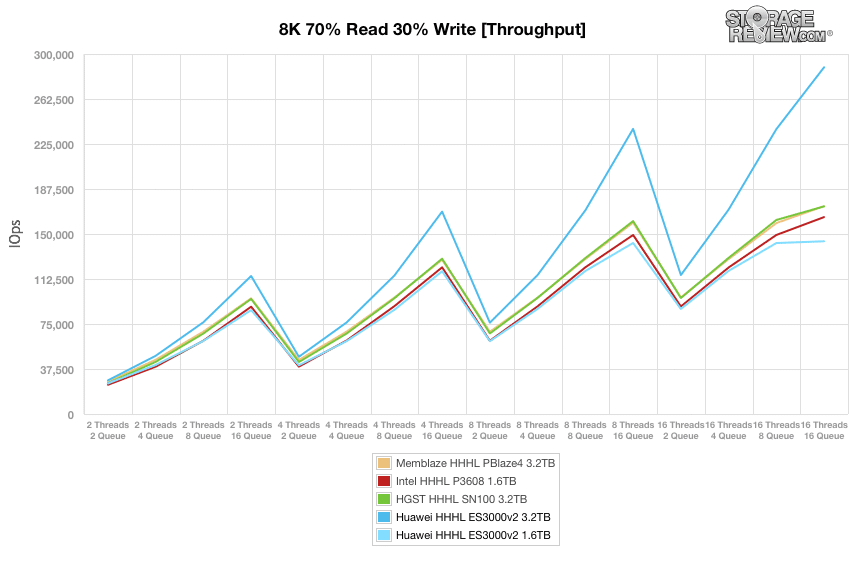
In average latency, the 2028U-TNR4T+ server showed excellent results with the Intel and Memblaze 2.5″ drives, both of which were neck and neck to until the very end with a range of roughly 0.2ms through 1.6ms. Looking at the 2028U-TNR4T+ when using the HHL drives showed better performance, with the Huawei ES3000 3.2TB model peaking at just under 0.9ms.
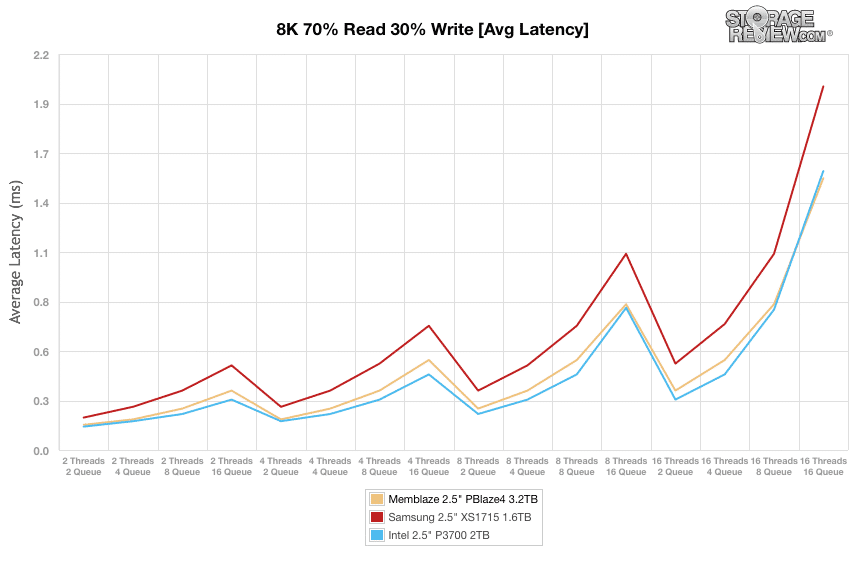
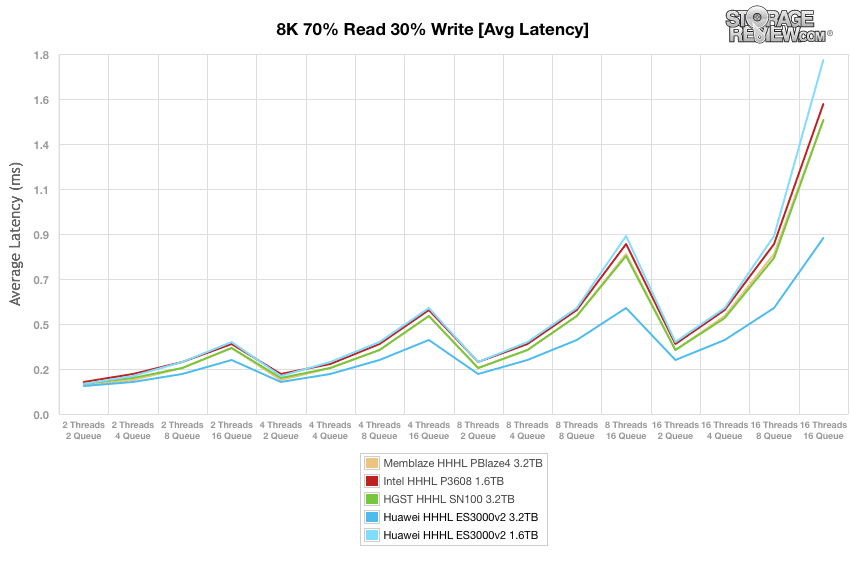
Conclusion
As a part of the 2U Ultra SuperServer line, Supermicro’s 2028U-TNR4T+ is an highly-capable storage solution with 24 hot-swappable 2.5″ drive bays, including 24 x SAS3 ports support via optional add-on cards. Residing inside the CSE-219UAC-R1K02 2U chassis, the 2028U-TNR4T+ leverages the X10DRU-i+ dual processor server board as the main subsystem of the device. The server is also equipped with four NVMe drive bays, which is very attractive enterprise buyers looking to tap into this powerful, low-latency technology. Additionally, the 2028U-TNR4T+ sports 24 DIMM slots for up to 768GB of DDR4 non-volatile RDIMM or 1536GB of LRDIMM DDR4 memory.
To test its performance, we outfitted the SuperServer with 768GB of Crucial DDR4 RAM (32GB x 24) and two Intel E5-2699v3 CPUs with the Supermicro AOC-S3008L-L8i HBA to enable the 24 SAS3 bays. We also populated it with three different sets of NVMe SSDs: the Intel SSD DC P3700, Memblaze PBlaze4, and Samsung XS1715, each of which were separately analyzed. Unsurprisingly, the combination of NVMe drives the 2028U-TNR4T+ SuperServer boasted a tremendous amount of throughput and extremely low latency. In our 100% read and 100% write 4k workload benchmark, the 2028U-TNR4T+ showed a top read IOPS of 717,172 when equipped with the Memblaze drive. When using with a load of 16 threads and a queue depth of 16 for 100% read and 100% write operations, the 2028U-TNR4T+ boasted a peak 166,250 IOPS (also using the Memblaze NVMe SSD) in the server.
Ultimately, the Supermicro offers businesses a very dense server platform as well as one of the industry’s highest levels of performance, efficiency, security, and scalability. No matter the storage interface preference, the 2028U-TNR4T+ has buyers covered with support ranging from SAS3 HDD/SSD for capacity, 2.5″ NVMe for hot-swappable low-latency performance to traditional PCIe flash offered in AIC form-factors.
Pros
- Fully loaded with plenty of high-performance storage potential
- Four 2.5″ NVMe bays
- Optional quad 10GbE as well as integrated SAS3 support
Cons
- The LP internal PCIe slot won’t fit some interface cards
The Bottom Line
The Supermicro SuperServer 2028U-TNR4T+ is oriented toward performance supporting NVMe in both 2.5” drive bays as well as well as AIC form factors. However the server also supports SAS and SATA which enables companies to leverage their current storage investments while future proofing for new technology.
Supermicro SuperServer 2028U-TNR4T+ product page
Discuss this review




 Amazon
Amazon